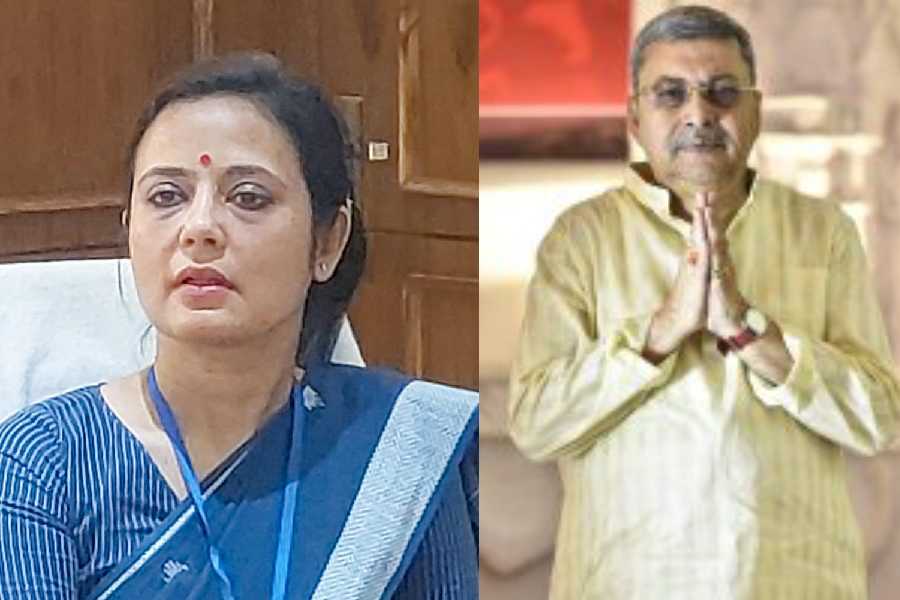 |
| Like Lear: A scene from Natyaranga’s Shah Jahan (Picture by Sanat Kr Sinha) |
Bengali theatre has reinvented a concept to populate its dwindling crowds: the supergroup. This involves a middle-ranking group inviting several star actors from outside to guest on a production, increasing its box-office appeal exponentially. While the method ensures commercial success, it can result in uneven performances as the director may find it difficult to integrate the stars — by definition unaccustomed to taking orders or changing their “style” — into his vision. It can also cause dissension within a group.
Two ongoing costume dramas reveal the supergroup phenomenon in practice. In Natyaranga’s version of D.. Roy’s Shah Jahan, the guests not only receive greater scope to display their thespian talent but also combine better possibly because they have worked with one another previously. Thus, Gautam Halder (as a decrepit Shah Jahan in his dotage) and Debshankar Halder (a schizoid Aurangzeb split between devotion and dogmatism) feed off each other owing to their experience in Nandikar. Director Swapan Sengu-pta also camouflages their typical deliveries by stressing Shah Ja-han’s geriatric quaver and Auran- gzeb’s muttering to himself. In comparison, Bijaylakshmi Barm- an behaves rather stiffly as the emperor’s daughter Jahanara. Surajit Bandyopadhyay’s editing makes the script more compact, yet retains Roy’s theme of history repeating itself and his obvious debts to King Lear (in Shah Jahan’s subplot) and Macbeth (in Aurangzeb’s).
Natadha’s Mahabharat, in contrast, does not leave an impact because it features too many stars — in fact, 50 performers from 15 groups — with the result that none of them gets the minimum time to build a role. Bibhas Chakraborty does his best as Dhritarashtra, but both he and Gandhari (Sima Mukhopadhyay) can only manifest blindness physically, with a walking stick and blindfold respectively. Cameos come from Dwijen Bandyopadhyay at the beginning as a meaningless Vidura and Meghnad Bhattacharya towards the end as a more significant but over-the-hill Karna. Clueless in Kurukshetra appears to be Debashis Roy Chowdhury’s part as Krishna, a choric commentator who has no idea what’s happening. Even the Pandavas (who could do with some body-building) look less perplexed. An angular, wildly gesticulating Shakuni is the pick of the characterisations, and a manipulative Draupadi the most unexpected.
Ultimately, one must ask why dramatist-director Shib Mukhopadhyay rewrote the mammoth epic into a play when he does not offer any specially new angle. Greater names like Peter Brook have tried, and been unable to condense it beyond five hours. To reduce it to two seems foolhardy. Mukhopadhyay’s thesis, that it shows how the thirst for power corrupts humanism, still does not justify this Vyasa-made-easy capsule, the equivalent of Charles Lamb retelling tales from Shakespeare.
Going by sheer popularity, the current blockbuster that repudiates the supergroup idea as the only way to draw audiences comes from that tightly-knit and -run unit, Nandikar. For Sojan Badiyar Ghat, you must book your seat days in advance. I am not equating full houses with aesthetic achievement, but Nandikar evidently has given the lie to Bengali groups’ complaints that nobody watches theatre any more.
Part of the magic is the style that Nandikar has developed over the last few years: a vibrant, full-blooded, large-cast, scenographically spectacular, song-and-dance extravaganza, a feast for the eyes and ears. Plus, they go about it with such professionalism and precision choreography that one can only marvel at the discipline and intensive labour underlying what we see on stage. Gautam Halder’s concept, dramatisation and direction of Jasimuddin’s poetic work continue this pattern.
Jasimuddin (1903-76) was a pioneering folk revivalist poet, who settled in East Pakistan after 1947. His verse has a simple, charming rural authenticity that gives it a near-pastoral feel, and many critics consider Sojan Badiyar Ghat as its acme. It tells of the love between a Muslim boy and Hindu girl, who elope, but he is jailed and she married off to a rich zamindar. After his release, the story moves to a Romeo-and-Juliet-like conclusion. Without polemics, it pleads strongly for communal amity.
Halder himself and Sohini Sengupta Halder portray the romantic leads vivaciously, and convey Jasimuddin’s favourite theme of doomed love sympathetically. Both sing (Halder also composed the music) and the huge cast contributes to the colourful ensemble. Sanchayan Ghosh yet again designs impressive sets with bamboo ghats jutting into both flanks of the auditorium.
This is not the first time Halder has attempted Jasimuddin; he applied similar treatment to Nakshikanthar Math for Kalyani Natyacharcha Kendra in 2000. It would be interesting if he shifted from Jasimuddin’s poems to his lyrical plays Beder Meye or Pallibadhu for a change, but using a different theatrical approach.










